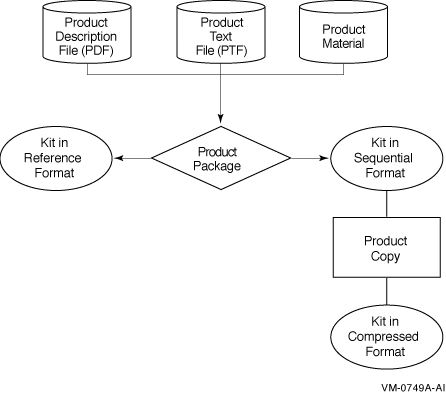 |
HP OpenVMS systems documentation |
| Previous | Contents | Index |
Package the software components to create a .PCSI file. This step is
fully described in Chapter 5. Use the PRODUCT PACKAGE command and
its qualifiers. The PRODUCT PACKAGE command determines if the PDF and
PTF are syntactically correct and verifies that all listed product
material files can be found.
1.3.6 Step 6: Test and Debug the Installable Kit
When a kit has been successfully produced, use the PRODUCT INSTALL, PRODUCT SHOW, and PRODUCT REMOVE commands to verify the installation and removal of the product. Check for correct file placement and protection, test user input, review message text, modify configuration options, verify that execution environment requirements are satisfied, and so forth.
Test your installable kit to make sure that it properly handles any software version dependencies.
This chapter defines key terms and concepts. Read this chapter before creating your installable kit.
This chapter describes the following topics:
If you are familiar with the POLYCENTER Software Installation utility terms and concepts, you can
start with Chapter 3.
2.1 The Product Database
The product database (PDB) refers to a set of interrelated files located in SYS$SYSDEVICE:[VMS$COMMON] with a .PCSI$DATABASE file extension. The POLYCENTER Software Installation utility automatically creates the PDB the first time a product is installed or registered on the system, such as when the OpenVMS operating system is installed. Once created, the utility updates the database as operations are performed to install, reconfigure, register, or remove products.
The PDB is the single source of information about operations performed on products using the POLYCENTER Software Installation utility. This information includes a history of operations performed, which products are installed, which files and other managed objects are owned by each product, software dependencies among products, and so forth.
The PDB consists of three permanent files:
A product-specific database file is created each time a product kit is installed or registered, and deleted when the product is removed. For example, the layered product TNT V3.0 for OpenVMS VAX might have a database file named DEC-VAXVMS-TNT-V0300.PCSI$DATABASE.
The format and content of the database files are controlled by the POLYCENTER Software Installation utility. If an OpenVMS system manager uses the POLYCENTER Software Installation utility to install your product, the utility will expect the database files to exist from that point on. Caution your product's users not to delete these files or the POLYCENTER Software Installation utility will not be able to detect and manage your product. The complete set of database files must be intact for the utility to access the information in the database. |
As a software provider, you can use PDL statements to query the product database to dynamically determine the version of an installed product. The following example illustrates how installation choices are made based on the installed version of OpenVMS on an Alpha system:
if (<software DEC AXPVMS VMS version minimum V6.2> AND
<software DEC AXPVMS VMS version below A6.3>) ;
file [SYSEXE]TNT$SERVER.EXE generation 5
source [000000]TNT$SERVER_V62.EXE ;
file [SYSEXE]TNT$UTILITY.EXE generation 1
source [000000]TNT$UTILITY_V62.EXE ;
file [SYSTEST.TNT]TNT$SERVER_IVP.EXE generation 5
source [000000]TNT$SERVER_IVP_V62.EXE ;
end if;
if (<software DEC AXPVMS VMS version minimum V7.0> AND
<software DEC AXPVMS VMS version below A7.1>) ;
file [SYSEXE]TNT$SERVER.EXE generation 5
source [000000]TNT$SERVER_V70.EXE ;
file [SYSEXE]TNT$UTILITY.EXE generation 1
source [000000]TNT$UTILITY_V70.EXE ;
file [SYSTEST.TNT]TNT$SERVER_IVP.EXE generation 5
source [000000]TNT$SERVER_IVP_V70.EXE ;
end if;
|
OpenVMS users can use the DCL command PRODUCT SHOW either to query the product database to show what products are installed and the dependencies between them, to list the files and other objects that make up each product, or to show the history of installation and upgrade activity.
If your installation procedure or the OpenVMS user removes a product,
information about the files and objects associated with the product are
removed from the database. However, the history of the product's
activity from installation to removal is retained in the database.
2.2 Software Product Kit Formats
When you create a software product kit, you must also choose a distribution format. You may choose one of three distribution formats:
Figure 2-1 shows how the package operation uses the PDF, PTF, and product material to create a product kit in reference or sequential format. Subsequently, the copy operation can be used to transform a sequential kit into a kit in compressed format.
Figure 2-1 Package Operation

The POLYCENTER Software Installation utility adheres to the following file-naming conventions when
either creating a software product kit or processing PDF and PTF files.
2.3.1 Sequential Format
A software product kit created in sequential format is a single file whose name is in the following format:
producer-base-product-version-kittype.PCSI |
For example:
DEC-AXPVMS-DWMOTIF-V0102-6-1.PCSI |
Note that the file name is constructed of components delimited by hyphens (-). The version component is further divided into subfields and includes an additional hyphen as explained in Section 2.3.5.
| Previous | Next | Contents | Index |